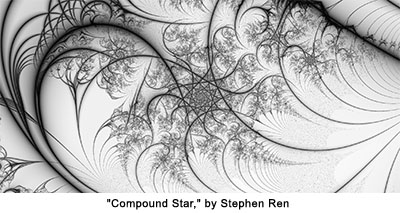
Mathematical ImageryMathematical artists create strong, stunning works in all media and explore the visualization of mathematics
Fractal Experiments :: Stephen Ren
I had always known the beauty and power of mathematics, but after discovering the connection between complex numbers and fractals, I became deeply fascinated in how fractals express and reflect that beauty. Whereas mathematical beauty often lay in abstract concepts and elegant proofs, fractals bring the beauty of mathematics plainly to the surface, unobscured and for all to see. Following my curiosity, I wrote a Java program to generate and explore fractals, as I find that creation and experimentation often brings about a deeper sense of understanding than just observation. At the time I had just tackled a number theory problem regarding tetration (super-exponential functions), and decided to generate fractals based on that. After generating the fractal, I experimented with changing my rendering method a little bit, and to my surprise, a completely new form of fractals emerged, which is shared here. No matter how much I think about it, I am still amazed that the basis of these images is purely mathematics, and I hope to share that beauty here in this gallery.
— Stephen Ren, North Hollywood, CA

This image is centered on 0.9073 + 2.354i, and is magnified 50x from the original fractal. This figure shows up repeatedly within the fractal, not only in isolation, but often within in other patterns and figures. This particular pattern bears resemblance to the Kneser's Chi-Star function. This image was created with 100 iterations of tetration.

This image is centered on 0.170938545, and is magnified 6000x from the original fractal. This figure can be found repeated in many areas along the real axis, though it is often deeply blurred in a larger figure. This image is generated with 400 iterations of tetration.

This image is centered on -2.5, and is focused on the somewhat hexagonal figure found primarily to the left of the imaginary axis. This is magnified 3x from the overall image. This image was generated with 100 iterations of tetration.

This image is centered on -4.125, magnified 40x from the original fractal. The overall shape of this figure is just barely visible in the complete depiction, but, as shown in this image, it is heavily laced with detail. This figure is particularly interesting because it is set apart from the rest of the "main" fractal body, and further so far I had not found it repeated elsewhere in the fractal. This image was created with 100 iterations of tetration.

This image is centered on 0.9717 + 2.21i, and depicts an endless sequence of "compound-star" figures. This image was produced with 100 iterations of tetration.

This image is centered on -1.5798, and is magnified 6500x from the original fractal. It is generated with 100 iterations of tetration.

This is the main fractal, and all the other images in this gallery are zoomed in from here. This image is centered on the origin, with the real axis ranging from -6 to 6 and the imaginary ranging from -3.375i to 3.375i . This image was generated with 100 iterations of tetration.

The base function for all these images is still simply standard tetration, the only difference being that color (or shade) of each pixel (representing a point in the complex plane) is dependent on the maximum reference angle of that point as tetration is repeatedly applied, rather than whether or not the magnitude of that point would increase without bounds, the latter being what standard tetration fractals are made from. I was astonished that such a small change would produce such intricate results that were quite different from normal tetration fractals.


